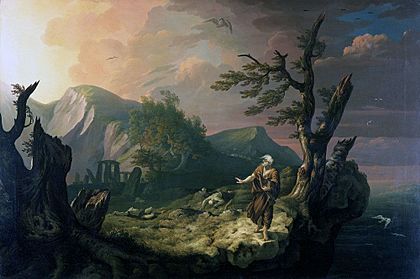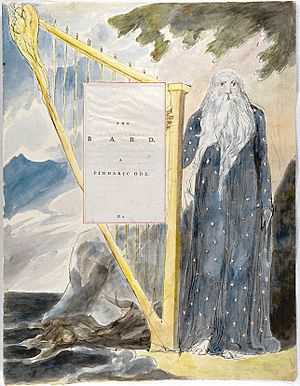The Bard (poem) facts for kids
The Bard. A Pindaric Ode (1757) is a famous poem by Thomas Gray. It tells a story from the time of King Edward I's conquest of Wales. Gray was inspired by old stories and Welsh harp music. This poem became very important for future writers and artists. Many people see it as the start of the Celtic Revival and the Romantic movement in Britain.
Contents
What is The Bard About?

The poem begins with King Edward I's army marching through the Snowdonian mountains in Wales. They are near the river Conwy. Suddenly, they meet a Welsh bard, who is a poet and singer. This bard curses the king.
The Bard's Curse and Prophecy
The bard calls upon the spirits of Cadwallo, Urien, and Mordred. These were three people King Edward had defeated. The spirits then show the bard the future of Edward's family, the Plantagenet line. They speak of the troubles and bad luck that will happen to Edward's descendants.
The bard also predicts that Welsh rule will return to Britain. This will happen through the House of Tudor. He also foresees a time when British poetry will shine brightly. He mentions great poets like Spenser, Shakespeare, and Milton.
Finally, the bard tells King Edward:
["]...with joy I see
The diff'rent dooms our fates assign.
Be thine despair, and scept'red care,
To triumph, and to die, are mine."
He spoke, and headlong from the mountain's height
Deep in the roaring tide he plunged to endless night.
After speaking, the bard jumps from the mountain into the river below.
How The Bard Was Written
Thomas Gray loved studying history, especially the old Welsh poetry. He didn't learn the Welsh language, but he took many notes on Welsh poetry styles. Gray also learned about a legend that said King Edward I hanged all the Welsh bards. This was because they encouraged people to fight against him. This legend, even if not true, inspired Gray.
Inspiration and Completion
Gray also studied old Scandinavian stories. He found a line in an Old Norse poem that he used in The Bard. He started writing the poem in 1755 and quickly finished two-thirds of it. Gray felt a strong connection to the poem, saying, "I felt myself the Bard."
However, he found the last part difficult to write. The poem remained unfinished for two years. Then, in 1757, Gray went to a concert. He heard John Parry, a blind harp player. Parry claimed his harp music was very old, going back to the druids. This music inspired Gray so much that he finished The Bard with new energy. He told his friend William Mason that Parry's music helped him finish the poem.
Publication Details
Gray sold the rights to The Bard and another poem to a publisher named Robert Dodsley. The book was printed by Gray's friend Horace Walpole at his home, Strawberry Hill. The book, called Odes by Mr. Gray, was published on August 8, 1757. It was a nice-looking book and sold for one shilling. Gray had to add some notes to the poem to explain it, even though he didn't really want to. He thought if a poem needed notes, it wasn't clear enough.
The Bard's Big Impact
The publication of The Bard changed English poetry. It was one of the first "primitivist" poems. This means it looked back to ancient, wild, and simple times. Its success encouraged many new writers to explore Welsh and Gaelic themes from the past. This movement became known as the Celtic Revival.
Influence on Writers and Artists
One writer influenced by Gray was James Macpherson. He wrote popular prose poems under the name of an ancient bard, Ossian. These stories spread the magic of Celtic culture across Europe and America. Walter Scott's popular stories about Scotland's past were also inspired by The Bard.
Many people see The Bard as a very early example of Romanticism. This was a big movement in art and literature that focused on emotion, nature, and individualism. The poem also influenced later writers like Ernest Renan, Matthew Arnold, and even W. B. Yeats. The word "bard" itself, meaning a great poet who speaks for a nation, became common in English because of Gray's poem.
The Bard in Other Art Forms
The poem has inspired many artists, sculptors, and musicians over the years.
Visual Arts
- Paul Sandby, An Historical Landskip Representing the Welsh Bard in the Opening of Mr. Gray's Celebrated Ode, 1761.
- Thomas Jones, The Bard, from Mr. Gray's Ode, "But oh! what glorious scenes", 1774, oil on canvas. This painting is at the National Museum of Wales.
- Henry Fuseli, a series of drawings from 1770–1778.
- Benjamin West, The Bard, 1778, oil on oak. This painting is at Tate Britain.
- William Blake, a series of illustrations from around 1797–1798. These are pen and watercolour drawings.
- J. M. W. Turner, Caernarvon Castle, 1800, watercolour on paper. This is at Tate Britain.
- John Martin, The Bard, around 1817, oil on canvas. This is at the Yale Center for British Art.
- William Etty, Youth on the Prow, and Pleasure at the Helm, a line from the poem. This painting is at the Tate Gallery.
Sculpture
- William Theed, The Bard, 1858, made of marble. This sculpture is at Mansion House, London.
Music
- John Callcott, The Bard, for singers, chorus, orchestra, and continuo, 1786.
- William Horsley, Cold is Cadwallo's Tongue, around 1810. This is a type of song called a glee.
- Edwin George Monk, The Bard: A Selection from Gray's Ode, for baritone, chorus, and piano, 1856.
- Charles Villiers Stanford, The Bard: A Pindaric Ode by Thomas Gray, for bass, chorus, and orchestra, Op. 50, 1892.
Theatre
- James Boaden, The Cambro-Britons, 1798. A part of this play acts out The Bard.


